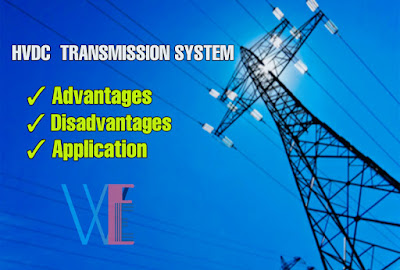HVDC Transmission System | Advantages of HVDC System | Disadvantages of System | Application Of HVDC System
HVDC Transmission System | Advantages of HVDC System | Disadvantages of System | Application Of HVDC System
Advantages of HVDC Transmission System:
All the advantages are mentioned below:
✓ Only two conductors are used for transmission, hence cost of transmission is
less.
 |
| HVDC Transmission System | Advantages of HVDC System | Disadvantages of System | Application Of HVDC System |
✓ Losses of transmission are reduced since there is no reactive power.
✓ Due to high voltage transmission,current is less for same power. Hence IR loss is very small.
✓ Due to DC transmission, there is no skin effect. Hence thin conductors can be used. But in AC transmission, the conductors must be thick to take care of skin effect.
✓ HVAC induces body currents in the vicinity of the conductors.This is absent in HVDC.
✓ Two ac systems of different frequencies can be connected through HVDC system. This is not possible in HVAC.
✓ HVDC uses electronic converters.Hence protections can be implemented faster than HVAC.
✓ HVDC do not have any dielectric loss heating problems in an insulation of conductors.
✓ HVDC have minimum audible noise,radio and TV interference.
✓ Power levels on HVDC can be electronically controlled in case of faults.
✓ DC cables are cheaper than ac cables used for transmission.
✓ Due to bipolar transmission,the voltage levels are balanced with respect to an earth.
✓ Line charging and electric resonance effects are absent in HVDC.
Disadvantages of HVDC Transmission:
✓ The cost of converters is high.
✓ Converters control is quite complex.
✓ Additional filters are required that increases the cost.
Comparison between HVAC and HVDC Transmissions:
Comparison point 1:
Type of Transmission:
HVAC : AC transmission
HVDC : DC transmission
Comparison point 2:
Overall losses
HVAC: High
HVDC: Low
Comparison point: 3
Cost of transmission
HVAC: High
HVDC: Low
Comparison point 4:
Cost of equipment
HVAC: Low
HVDC: High
Comparison point 5:
Power control
HVAC: Power cannot be controlled
HVDC: Power can be controlled
Comparison point 6:
Directionality of link
HVAC: Unidirectional
HVDC: Bidirectional
Comparison point 7:
Transmitted power and distance
HVAC: Depends upon distance.
HVDC: Independent of distance.
Applications of HVDC Transmission
HVDC Transmission has following applications which is mentioned below:
✓ Underground and underwater cables.
✓ Long distance bulk power transmission.
✓ Asynchronous interconnection of AC systems
✓ Power flow stabilization in integrated power system.

Comments
Post a Comment